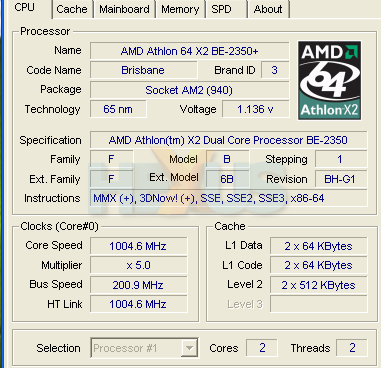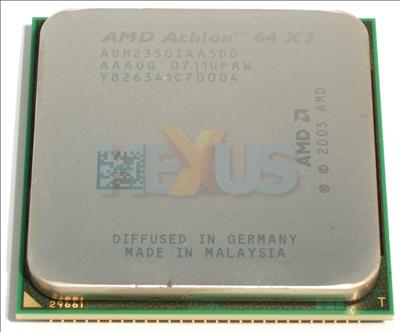AMD Athlon X2 BE-2350
AMD may not be quite the force it once was at the very high end of the desktop market, with that area dominated by Intel's Core 2 Extreme processors, but its low-end offerings still offer significant value-for-money.
Based on the K8 core and presented in various guises - Athlon 64 X2, Athlon 64, and AMD Sempron - that are differentiated on the basis of execution cores; on-chip cache, manufacturing process; and form-factor, there's something for practically everyone, especially if your purse-strings don't extend to triple figures.
Out of the 100+ processors listed on AMD's site, the most interesting, we feel, are the BE-series, comprising of BE-2300, BE-2350, and BE-2400 processors.
| Processors | Clock speed | L2 cache (total) | Voltage | TDP | Process | Price |
|---|---|---|---|---|---|---|
| AMD Athlon X2 BE-2400 | 2.3GHz | 1MiB (2 x 512KiB) | 1.25V | 45W | 65nm | £62 |
| AMD Athlon X2 BE-2350 | 2.1GHz | 1MiB (2 x 512KiB) | 1.25V | 45W | 65nm | £53 |
| AMD Athlon X2 BE-2300 | 1.9GHz | 1MiB (2 x 512KiB) | 1.25V | 45W | 65nm | £49 |
The reason for such interest lies with their power ratings for what amount to full-blown Athlon 64 X2 dual-core processors. All three processors ship with 1MiB of L2 cache and are rated to with a 45W TDP, compared to 65/89W for other similar X2 parts. How has such a power-saving been made possible, you may wonder.
First off, the fastest of the trio, the BE-2400, is clocked in at only 2.3GHz; some way below the 3.2GHz Athlon 64 6400+. Aiding the possibility of hitting a low-ish TDP, AMD manufacturers them on its 65nm process in Dresden, Germany. The net result of relatively low clocks and a low-power process is enough to qualify certain parts at just 45W.
Knowing that this very architecture can scale to 3.2GHz and taking due account of the low TDP rating on the series, it's only logical that they should overclock well - that's the theory, anyway.
We took the middle of the trio, an off-the-shelf BE-2350, and benchmarked it at both stock and overclocked speeds.
But before the benchmarking shenanigans are revealed, let's take a closer look at the BE-2350.
AMD's wonderful naming structure is such that the BE-2350 has the same attributes as a 65nm Athlon 64 X2 4000+, so a 2.1GHz clockspeed, 1MiB L2 cache, 65nm process, and AM2 form-factor. The bonus here is a lower TDP: 45W vs. 65W
The processor-in-box (PIB) cooler is the same as the 3800+'s, however.
Decent contact is made with the CPU, clearly.

Here's the processor idling using Cool'n'Quiet technology.

And here's the under-load default speed of 2.1GHz. The vagaries of AMD Athlon (64) X2 multipliers are such that RAM speed is dictated by a range of integer divisors. In this case, setting the DDR2 speed as close to 800MHz - but not going beyond it - necessitates a divisor of 6, resulting in a stock-clocked memory speed of just 703MHz. Using a divisor of 5 would have lead to an effective speed of 844MHz.
Overclocking
The method of overclocking is simple enough. We used the reference cooler with no additional cooling aimed at the CPU. Using an ASUS M2N32-SLI Vista Premium nForce 590 SLI motherboard, we increased the processor's voltage to 1.3375V, up from the default 1.25V, and ramped up the HT clock.We managed a safe, stable overclock up to 268MHz HT clock, leading to an overall CPU speed of 2.814GHz - an increase of 33 per cent above stock. This time, using a divisor of 7, system memory was run at DDR2-804

We managed to increase the overall processor speed to 2.95GHz with reasonable stability, but backed off to the speed shown above, indicating what's eminently achievable with a G1-stepping processor.
But how does the budget-oriented competition compare?












